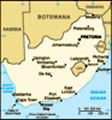Advertisement
Published: February 8th 2023
Turtles have a tough start in life. First, they must break-out of their soft egg and then start digging - turtle eggs are buried deep in soft sand, as much as a metre down. Once the baby turtle makes it to the surface, it must use its flippers to move down the beach and into the sea, up to 100 metres away and only the moonlight reflecting on the waves to guide it. And, on the way, waiting predatory crabs must be avoided, baby turtles are their favourite snack.
We're on Sodwana beach and the first of the baby turtles have already made it into the sea, leaving tiny flipper tracks across the sand. Dotted about on the sand are the less sucessful ones, exhausted or disorientated or both and about to become crab fodder. Not on our watch they aren't! We shoo off the crabs and use torches to lead the turtles towards the sea - they always walk towards the light. After our shoes get totally swamped by an incoming wave, we realise there is a downside to walking backwards into the sea leading lost baby turtles.
Then we run back up the
beach to where still buried turtles are being freed; those at the bottom of the nest have a tough climb to get out and many need a helping hand from our expert guides. Covered in sand, the tiny turtles start to stagger down the beach but they clearly aren't going to make it. We do what we can to help them to the water's edge; at least they have a chance once they are into the water. Grumpy crabs scuttle about just out of sight.
A turtle nest contains as many as 150 eggs; the first nest we found was of leatherbacks and the second loggerheads. Baby turtles have about a 1% survival rate - perhaps a little higher with our help tonight?
Sodwana beach is an extraordinary place; miles and miles of fine sand backed by high dunes; great for walking and completely empty. The beach is protected as it lies within the Isimangaliso wetlands, a UNESCO world heritage site that runs along the coast; it is a vast area of lakes, marshes and forests. Our house is on stilts just above one of the lakes; impala, nyala and tribes of banded mongoose
run around below us and ibis and kingfishers fly overhead. We didn't see any of the hippo or crocodiles who live in the lake …
From Sodwana we drive west across KwaZulu-Natal. Initially the landscape is flat and we pass huge fields of sugar cane and, later, fruit and maize. As it gets hillier, the soil gets poorer and it is mostly rough pasture for cattle and, eventually, we start to see our destination in the distance, the Drakensberg mountains, its peaks wreathed in dark clouds. Our cabin at Thendele is high in the mountains at 1600 metres; its spectacular view is an amphitheatre of high peaks, a near vertical wall of rock reaching up to over 3000 metres.
We decide to walk early in the morning as it will still be hot by lunchtime even at this height. The first trail we follow shadows the Tugela river which gently climbs up the valley towards the higher peaks. As we climb, the valley narrows and curves and we are soon walking at the bottom of a rock cliff with the river thundering below us. The small streams that we have been crossing now become
waterfalls that cascade down the rock faces or fall vertcally into the forest from overhangs high above us. We dodge behind and around the falling water, trying to keep reasonably dry.
Eventually we reach a stream that we cannot cross; we've been boulder hopping for a while. The rock walls tower over 1 km above us and we can now see the Thukela waterfall, the highest in the world; in five stages it falls over 950 metres.
Our cabin is set in grassland that is dotted with protea bushes. These can survive forest fires and their blackened branches show that have done so; the park's policy is to burn grassland areas on a three yearly cycle. Mountain reedbuck and baboons live here too and wander around outside the hut. Baboons are a real nuisance as they like to raid the cabins - they jump onto the roof, look through the windows and have even learnt how to open any unlocked doors.
Every evening the clouds rolls in and, sometimes, it rains. Then each morning we wake to another cloudless blue sky. We walk three more of the park's excellent, well marked
trails, finding lookouts, more waterfalls and interesting flora. We're surprised to find tree ferns, they must cope with the heat reasonably well; we recognise many plants from our garden, here growing wild.
Tomorrow we will leave South Africa again, this time to visit mountainous Lesotho.
Advertisement
Tot: 0.064s; Tpl: 0.012s; cc: 10; qc: 25; dbt: 0.0418s; 1; m:domysql w:travelblog (10.17.0.13); sld: 1;
; mem: 1.1mb
























